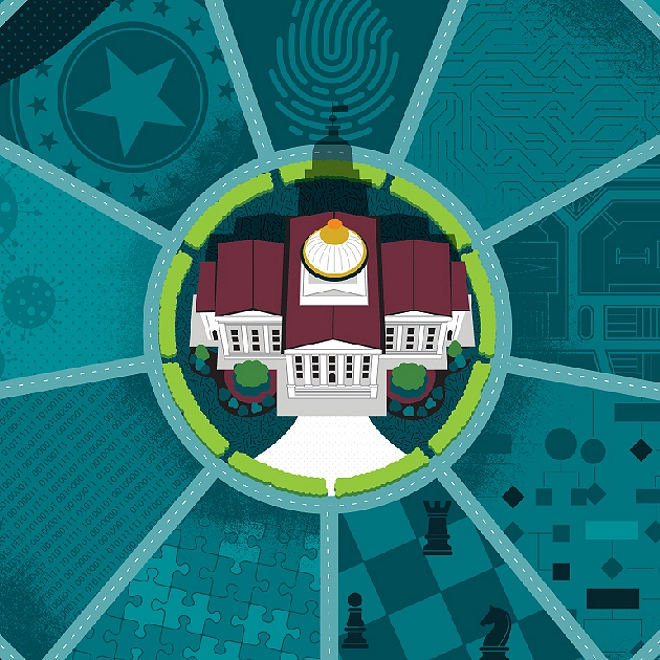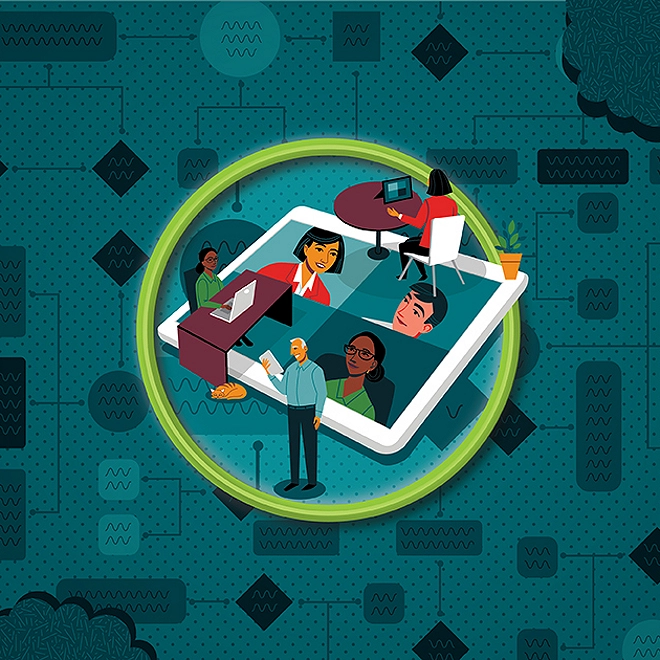Inclusive, equity-centered government
Embedding greater inclusion, diversity, and equity into the public sector
Governments should reflect societal values. As inclusion, diversity, and equity issues come to the forefront, governments are beginning to recognize the importance of addressing the underlying causes of systemic imbalances and question the fundamentals of how policies are made, implemented, and assessed.
Inclusion generally means ensuring that all people feel valued, respected, and welcomed within a team, workplace, organization, or society.1 Equity generally refers to taking steps to ensure fair access to resources and other policies that encourage the advancement of all people, especially those facing disadvantages.2
Inclusive, equity-centered government seeks to address historical imbalances in resources and structural barriers to opportunity, and operates at the intersection of disadvantages that may be based on race, gender, sexual orientation and identity, disability, and socioeconomic status. Also, it acknowledges the role of policymaking and program development in perpetuating these disadvantages further.
Finally, the aim is to address systemic racism and systemic inequity in multiple areas, including policing, criminal justice, education, health care, housing, business support, and even government talent management. This demands a systemic change in government functioning.
In the following sections, we discuss some of the most prominent inclusion and equity-centric approaches being embraced by governments around the world.
Inclusive and equity-centered design
The concept of inclusive design, also known as universal design, is not new. Governments have been employing this approach for decades, primarily in the form of infrastructure improvements that accommodate physical disabilities—think audible walk signals and wheelchair ramps.
What is new is the expansion of this concept beyond physical infrastructure and accessibility needs. As governments seek to make their services accessible to every citizen, they are rethinking program structures, communication platforms, and digital algorithms. They are looking to accommodate those with physical limitations, learning and language differences, and mental health disorders.
For instance, Kenya partnered with UNICEF to design an accessible education system for children with hearing and visual impairment and intellectual disabilities, distributing easy-to-use digital devices with multimedia overlays that combine features such as audio narration, sign language videos, interactivity, and audio-description of images.3 In India, when the government launched its mobile app to provide information about COVID-19, it took into account that the majority of its citizens didn’t have access to smartphones, and thus created an interactive voice response system with an easy-to-remember phone number.4
Governments are also focusing on institutionalizing the design thinking process to solve complex problems. For instance, Norway’s StimuLab helps state and municipal entities apply design principles and processes to stimulate innovation in public sector operations and service delivery.5 StimuLab taps into the private sector expertise to solve complex societal problems using a broader toolkit beyond design thinking including, foresight, impact assessment, data analysis, and behavioral psychology. Since its inception in 2016, StimuLab has been driving a wide variety of projects, including preventing people from falling into financial instability, tackling societal exclusion, developing a roadmap for national digital archival systems, and cross-sectorial and public-private innovation.6 Across its projects, StimuLab uses a design thinking methodology called the “triple diamond”: The first diamond is the diagnostic phase—focusing on understanding the root causes of a complex public issue, establishing a shared understanding between stakeholders, and building commitment within the group. The second and the third phase focus on exploring ideas, testing concepts, and, finally, prototyping solutions and scaling.7
In addition, governments are also making a deliberate effort to move from inclusive to equity-centered design. For example, the Lab @ DC, a unit within the Washington, DC, city government, is redesigning government forms to improve access to city services.8 In 2017, the lab launched Form-a-Palooza, using human-centered design principles and plain language to reduce design bias for 30 of the most commonly used forms.9 For instance, the previous application for reserved residential parking for mobility-impaired residents required them to get a doctor’s certificate, then go to the local department of motor vehicles to pick up a parking placard and get the application notarized, and finally go to the Department of Transportation to submit the form physically. All four steps required residents to physically visit each office to complete the process. The redesign eliminated the last two steps by removing the notary requirement and allowing residents to email the application form.10

Moving a step further, equity-centered processes and policies can help reduce systemic barriers faced by historically marginalized, oppressed, and excluded groups. For example, government policies regarding criminal conviction can remove access to myriad opportunities for previously incarcerated individuals. While some restrictions based on prior criminality may be appropriate, many policies needlessly handicap those convicted of minor offenses from finding work. In 2018, for instance, the White House announced a program to help Americans who are reentering society from prison find jobs. In 2015, the state of New York launched Project Reset, a diversion program that provides an alternative to individuals who have committed low-level crimes from having these infractions appear in a criminal record report.11
The application of design thinking and human-centered design in the above examples is just the tip of the iceberg. Design principles can be applied to mitigate, and even eliminate, systemic and historic discrimination in a plethora of areas such as housing discrimination, algorithmic bias in financial lending, and unconscious bias in criminal legislation.
 Equitable access to public goods
Equitable access to public goods
Citizen access to public goods can highly impact economic success. Children from a low-income neighborhood with underfunded schools, high crime rates, and limited access to internet—most prevalent in rural communities—face myriad additional challenges on the already difficult road to adulthood.
Governments are increasingly seeking to ensure more equitable distribution of public goods. That said, there are a number of critical success factors that aren’t related purely to public goods but are influenced by public policy. Low-income communities are often the last to receive new communication technologies, such as 5G,12 and often have limited access to facilities such as health care and recreation. Policy can also influence private sector lending, housing, and employment practices to address inequalities and discriminatory practices.
Governments have a central role to play in providing equitable access to public goods and using policy tools to influence equitable access to quasi-public and private goods and services (figure 1).

New Zealand’s Digital Inclusion Blueprint focuses on four key elements: access, skills, trust, and motivation. Beyond access to internet, devices, and content, the blueprint focuses on improving digital skills required to use them, ability to trust what one sees and does online, and making the digital experience more meaningful for each community.13 The goal is to ensure everyone can “participate in, contribute to, and benefit from the digital world.”14 In the United States, President Joe Biden has called for a US$20 billion investment in rural broadband infrastructure to bolster employment opportunities for those living outside of urban areas.15
In the health equity area, Public Health England has identified reducing health inequality as a key priority for both its 2020–2025 Infectious Diseases Strategy and its NHS Long Term Plan. The agency cited evidence that doing so can improve life expectancy and reduce disability across the whole population.16
Another way of addressing health inequity is to focus on social determinants of health (SDOH): conditions in which people are born, grow, live, and work, along with surrounding social structures and economic systems that shape these conditions.17 Governments, acknowledging the strong linkages between SDOH and health outcomes, have sharpened their focus in this area. For instance, the state of Arizona now requires Medicaid managed care organizations to coordinate community resources such as housing and utility assistance along with health care.18
Transportation, especially public transit, can directly impact economic justice by providing better access to workforce opportunities, healthy food, and education.19 The Housing + Transportation Index puts forth an analysis that relooks at the definition of “housing affordability.” The analysis asserts that nearly 55% of US neighborhoods can be termed as affordable, but when transportation costs are factored in, that number falls to 26%. It stresses the importance of government agencies planning public transit and mobility options more holistically.20 For instance, the Department of Transportation of Washington, DC, requires dockless vehicle rental services to offer non-smartphone-based access options and pricing plans for low-income neighborhoods.21
Many governments have used an equity lens in their COVID-19 responses, too. For example, the New York City Department of Health used data to identify neighborhoods with low testing numbers and high positive cases—many of which were poor areas with overcrowded housing—and concentrated its testing resources there. The agency offered rapid testing and wrap-around services such as counseling or connection to health care providers to ensure equal access to services in these areas.22
Data sovereignty and data equity
Governments’ increased reliance on new artificial intelligence systems and algorithms has given rise to new concerns of data equity and data sovereignty. Data equity seeks to ensure that the data collected and analyzed for decision-making appropriately represents the underlying population and prevents bias against marginalized communities. Data sovereignty refers to the inherent rights individuals and communities have on the collection, ownership, and use of their own data.23
Data-driven decisions are only as reliable as the data they are based on. Therefore, if the underlying data undercounts or misses individuals belonging to different population subgroups such as race, age, ethnicity, gender, and living and social conditions, it can lead to inequality and bias. For instance, a report by the US National Institute of Standards and Technology found that in most facial recognition algorithms, the accuracy of algorithms worsens for specific demographic groups. The report found that facial recognition systems had the highest error rates (false positives) for people of color, women, and the elderly.24
In order to facilitate better decision-making, many governments are seeking ways to make data more representative of the population. The UK Office for National Statistics has adapted existing surveys and created new surveys to better understand the impact of the COVID-19 pandemic on certain population subgroups. The agency has additionally turned to existing census data to help understand how different groups are being affected by the virus.25 New York launched an Automated Decision Systems (ADS) Task Force in May 2019 to evaluate tools the city was using to help make decisions about service and resource allocation. The taskforce recommended ways to build equitable, effective, and responsible approaches to the city’s ADS.26
Data sovereignty focuses on the issue of data ownership—who should own individual and community data. Legislation such as the General Data Protection Regulation tends to focus on an individual’s right over data and its privacy. However, there is very little focus on the right of a community, such as indigenous communities, over its data. The International Work Group for Indigenous Affairs launched the Indigenous Data Sovereignty (ID-SOV) initiative that focuses on the right of indigenous people to own, control, access, and possess data that belongs to their members, knowledge systems, customs, and territories.27 The concept is derived from indigenous tribes’ inherent right to govern their peoples, lands, and resources.28
New Zealand’s Māori community is putting the concept of ID-SOV in action through the Tikanga in Technology project, which received US$6 million government funding for four years. One of the key objectives of the project is to explore tools, processes, and mechanisms to support IT workers in enabling ethical use of data and generate more equitable outcomes for the Maori.29
Cocreation and citizen engagement
Governments around the world are providing greater opportunities for individual citizens and communities to have a voice in creating policies and solutions that impact them. This “cocreation” model engages citizens and communities, fosters inclusive governance, and can lead to more equitable outcomes. Also, governments are focused on making citizen participation more meaningful and moving citizens up the “ladder of participation.” This means moving their involvement from simple activities such as information sharing and voting, to consultation and community involvement, to large-scale participation in decision-making.30
For instance, in Taiwan, the government used vTaiwan, an open source collaboration platform, to bring together citizens, academicians, and software developers to brainstorm ways to effectively respond to the COVID-19 pandemic. The platform served as an online town hall, involving citizens in policymaking and increasing civic trust.31 Because it was cocreated with the community, the diverse perspectives of community members were reflected in the policy ideas generated.
The Belgian city of Leuven frequently solicits citizen input on government decisions, from addressing climate change and COVID-19 to seeking ideas on how to make the city a better place. In September 2020, Leuven received an award from the European Commission for this innovative collaboration model.32 In another example, Portugal launched its nationwide Participatory Budget initiative in 2017. The process allows citizens to pitch and vote on public investments, giving them an active role in deciding which projects are funded and implemented. Program officials visit both major cities and small villages to ensure they are receiving input from a broad range of constituents.33
Data signals
- In order to bring greater diversity in leadership roles, the Australian government has set a target of increasing the representation of Aboriginal and Torres Strait Islanders to 3% in the Senior Executive Services.34
- More than 30 US cities have created City Equity Offices since 2014. The offices evaluate government processes and service delivery with the goal of eliminating institutional inequities and discrimination.35
- In 2018, 258.4 million children, adolescents, and youth were out of school, constituting nearly a sixth of the total population in that age group.36
Moving forward
- Elevate the human experience by taking a holistic, people-first approach to the design and delivery of government programs. Adopt universal design principles for all government programs.
- Update outdated regulations and requirements to overcome systemic barriers to inclusion.
- Encourage citizen participation and cocreation to tackle complex challenges where stakeholders share responsibility for a problem and together develop a process for solving it.
- Collect and use data that represents all population groups and can be broken down to show realities within marginalized or disadvantaged subpopulation groups.
- Democratize data, making it available to individuals and communities and enabling them to design programs and services that suit their needs.
- For automated decisions, leverage tools and techniques that can automatically detect potential algorithmic bias to avoid decisions that are unfair to certain populations.
Deloitte Diversity, Equity & Inclusion Services
Deloitte’s diversity, equity & inclusion (DEI) consulting services change the world by taking a
systemic approach to help organizations access and engage a more diverse workforce; build
inclusive leadership capabilities; foster a culture of belonging; and embed equity and inclusion
across every business function.



